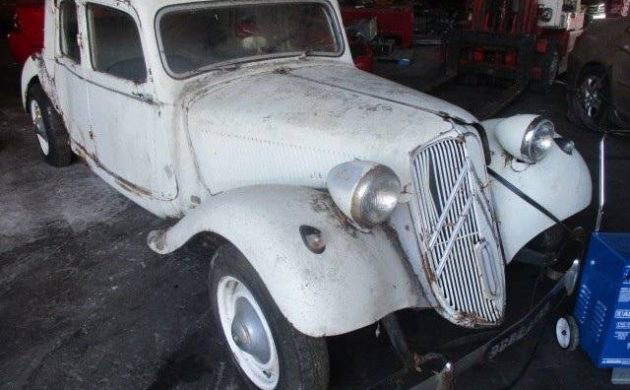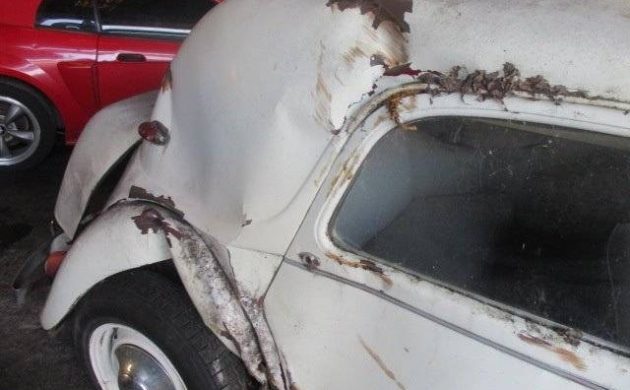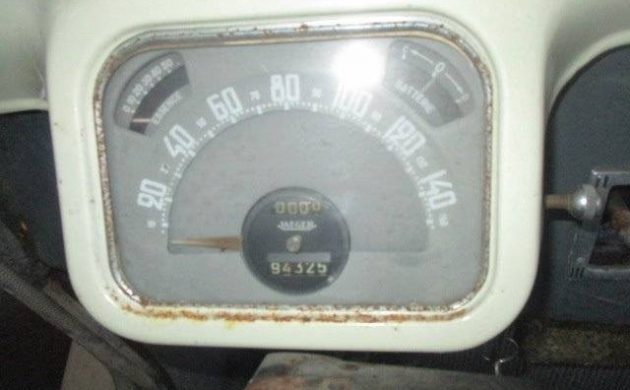Just the other day, I added a post that focused on the 1935 Audi 225 Cabriolet, a notable car for combining front-wheel drive with a six-cylinder engine. The novelty of a front-wheel-drive layout wasn’t unique to the Audi, as Citroen also made some significant engineering accomplishments with its novel Traction Avante. The Citroen was a few years behind the Audi, or Auto Union, innovations, but it made a name for itself owing to its emphasis on passenger safety and the mass utilization of rack-and-pinion steering. These are sought-after classics today, which is why it’s so tragic to see one clearly sitting in the confines of a wrecking yard and suffering from damage to its right rear quarter panel. Find the Citroen here on craigslist near Oakland with an asking price of $4,500.
Despite being offered by an entity called Cypress Auto Salvage, the seller seems to have some information on the car that would either come from knowing the vehicle personally or potentially belonging to a yard employee. The listing notes that prior to being wrecked, the Citroen benefitted from an engine rebuild featuring updated valves and seats to run on unleaded fuel. That’s the sort of detail that your typical yard owner wouldn’t know, or necessarily even care about, if the Citroen just showed up on the back of a flat bed one night. The damage is hard to pinpoint as being “fresh” or decades-old; based upon nothing at all, I’m inclined to say the latter. It looks to have damaged the roof as well.
French cars of this vintage seem to have interior upholstery that went to the MBTex school of durability and presentation: not particularly attractive, but also incredibly resistant to time and age. The seller only includes this one photo, so it’s hard to say whether the whole cabin survives in this sort of condition, or if the seats just benefit from a refresh that the rest of the cabin is still waiting for. The door panels look slightly tired here, but that could just be a trick of the lighting. The Traction Avant was offered in an extended wheelbase format, which offered seating for nine adults across three rows of seats. This is a standard wheelbase model.
Based on the condition of the trim ring around the speedometer, I would say it’s likely that the Citroen was never cosmetically restored. That’s OK – if it’s a lifelong California resident, the novel unibody chassis should be solid assuming it was properly stored. The Traction Avant is known worldwide as a significant vehicle, but unrestored examples can still be scooped up for reasonable money. If this one does have an engine refresh under its belt as the seller promises, it would seem worthy of revival – but one would need to determine just how extensive the accident damage is before taking that project on. Do you think its past the point of saving?








Providing no pics of the engine is a very poor way of advertizing a car of any type, especially one of these. If I were near Oakland, I’d sure take a look at this one.
Remove the extra « e » from the first occurrences of « Avante ». After all, it’s not a fronte wheel drive 😉
Frenchie cars are so much foo foo….did this have traction…wee wee…gimme a frickin beret
This was designed the same year as a Ford B. Only one was the future
Raymond,
you should really inform yourself a bit more about Andre Citroen and his cars before making snarly comments . This model, the Citroen “7”, evolved into the “11”, then a 6-cylinder version called “15”, was the world’s first high-production monocoque automobile, used a mid-engine design with its gearbox upfront, and was often quoted in both European and American period media as the best handling car in the world.
It lived from 1936 to 1956, when Citroen introduced the famous DS19, still a remarkable design to this day.
Oh, and another small detail: its gearbox internals powered the Formula 1 Cooper to two F1 world championship, creaming the period Ferrari, Maserati and all other Euro and British entries.
It is ‘Oui, Oui” not wee wee.
Your sparky and condescending remarks were just over-ruled by your lack of sophistication lol.
I like French Cars…Much to other peoples views. the French build the best cars. I have owned two in the past….a Citroen and a Renault. I did not have too much money in those days to fix them to a good Standard. The car makers did not apply rust paint or no paint underneath in those days.
Rolls Royce are good cars. Rolls, financed to start the Company and Royce was the engineer.
The French built the best cars — well, that is debatable, but what I would really like to know is what does Rolls Royce have to with any of this?
All we need to know, Gerard Frederick, is that your namesake above–with the surname BENTLEY–says that Rolls Royces are “good cars”. We all know Gerard Frederick’s love and admiration for English cars,and just how much you agree with your namesake…
That looks like a tree fall or something rather than a road accident. Nice cars though, but I’d want to haggle on price given the damage..
I am near Oakland: 22 minutes to this salvage yard, but there is not enough there there to make it worth the drive. I don’t do this kind of restoration but I suspect there are a few more surprises with this example beyond the roof damage. It was interesting to see it is noted as being an automatic trans though.
Leave alone. As a pioneering monocoque construction, damage like this is likely to be terminal and $15000 will buy you a good example.
I´ve had a couple of these and they are fabulous. Great to drive, the chassis is very capable and if you treat the gearbox with some respect, the cars are very strong
I suspect a preselector transmission, not auto. Depress clutch after selecting change de vitesse position. I think Cotal brand tranny. Lots of bodywork to do, but sure is attractive styling.
I would say this Citroen is worth preserving–even if just to use in Second World War films. The design remained quite consistent for close to a quarter century. However, to use in wartime and pre-war films, I would recommend that a second boot/trunk lid be either sourced or fabricated. The pre-war cars can be differentiated from the latter ones such as the one in the ad, by having a flatter/less roomy boot/trunk lid. For people who know these cars, there is nothing as frustrating as seeing a movie set during the war, or prior to it, and see a post-war variant with its bigger trunk/boot. Not all that long ago there was a 1950s Traction Avant used in a Nicole Kidman film about the 1936-39 Spanish Civil War. Agh…..
In the movie Patton! with George C. Scott, General Patton is seen in a 1945 scene, getting into a 1948 Packard limo. As a Packard guy, I have just assumed it was a pre-production model!
No Cotal automatic in the Tractions ever.
This seller hasn’t posted an engine pic which is inexcusable and hasn’t taken a close look at the dash shifter so doesn’t have a clue.
Fact is, Andre Citroen went bsnkrupt in ‘35 partly due to money wasted trying to develop a true automatic but failed.